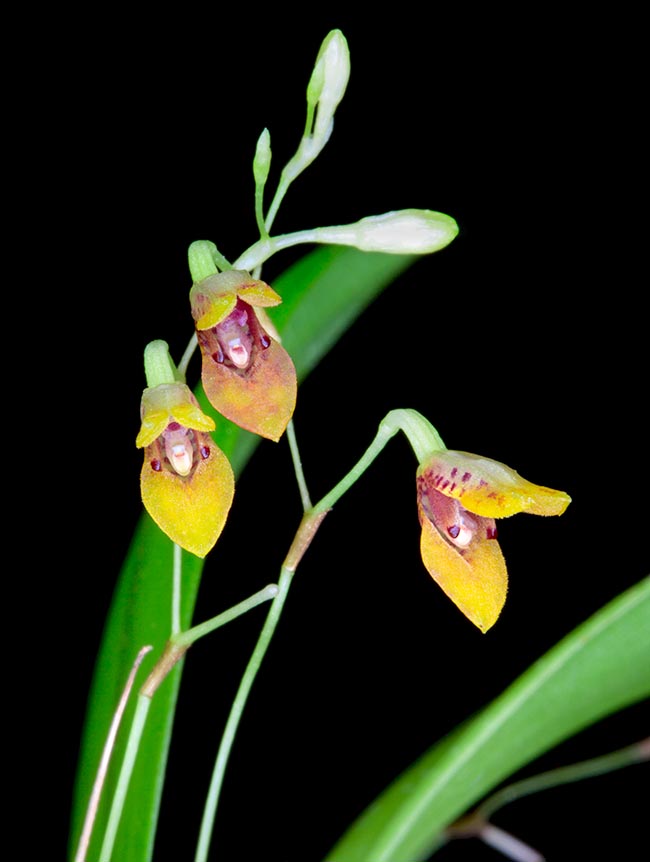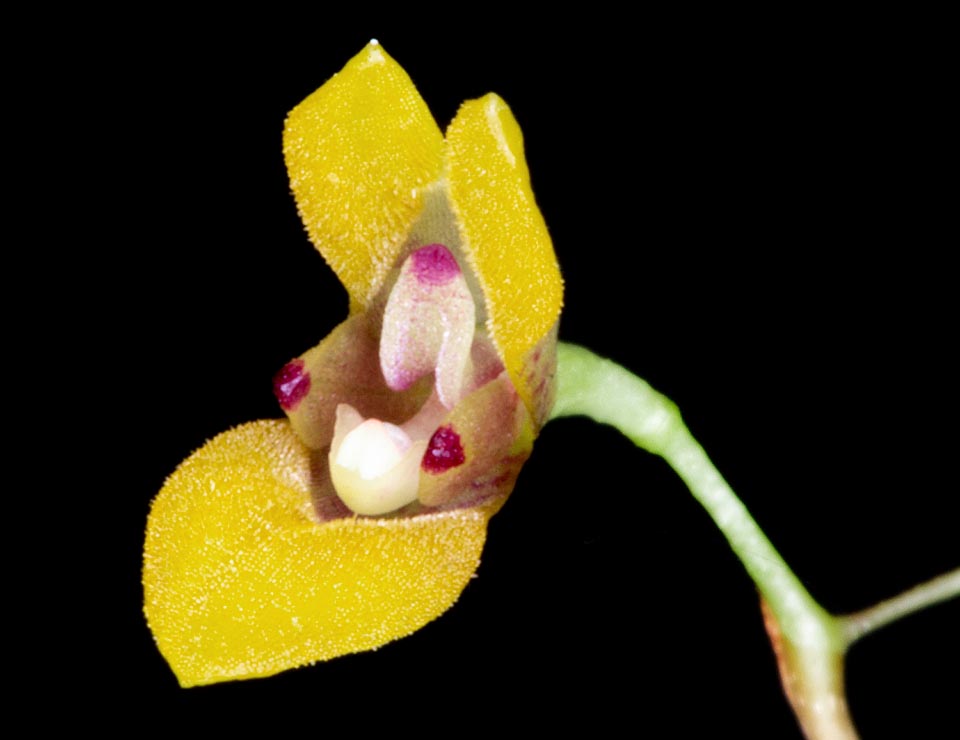Family : Orchidaceae

Text © Pietro Puccio

English translation by Mario Beltramini

Mini orchid, the Pabstiella fusca is a cespitose epiphyte of the humid Brazilian coasts © Giuseppe Mazza
The species is native to Brazil (Bahia, Espirito Santo, Minas Gerais, Paraná, Rio de Janeiro, Rio Grande do Sul, Santa Catarina and São Paulo) where it lives on the trees of the coastal humid forests as well as in the seasonally deciduous ones, up to about 1200 m of altitude.
The genus is honoured to the Brazilian botanist Guido Frederico João Pabst (1914-1980); the specific name is the Latin adjective “fuscus, a, um” = brown, with reference to the brown-purple spots of the flower.
The Pabstiella fusca (Lindl.) Chiron & Xim.Bols. (2010) is an epiphyte cespitose species with creeping rhizome and erect stems, spaced 2-5 mm, cylindrical and covered by two tubular sheaths, 1,5-3 cm tall and of 1-2 mm of diameter, unifoliate.
Obovate-lanceolate leaves with tridentate apex and long attenuated base, 5-8 cm long and 2-3 cm broad, of pale green colour. Racemose solitary inflorescences from the apex of the stems, 6-8 cm long, slightly curved, usually carrying up to 8 tiny flowers, on a 1-1,5 cm long filiform pedicel, and 2-3 mm long ovary, not resupinate (with the labellum above over the column) of very variable colour, yellow to reddish more or less dark purple spotted, that open 1-2 at the time on the zigzagging rachis.
Almost similar sepals, ovate-lanceolate with acute to obtuse apex, slightly concave, 7-8 mm long and about 2 mm broad.
Erect unguiculate petals, lanceolate with acute apex, 3-4 mm long and 1-2 mm broad, obovate-lanceolate labellum with acute apex, fleshy, 3-4 mm long and 1-2 mm broad, and claviform column, about 3 mm long, of pale yellow colour.
It reproduces by seed, in vitro, but usually and easily by division with each section provided with at least 3-4 stems.
Mini orchid of easy cultivation forming dense tufts and flowering repeatedly during the year, requires a semi-shady position, intermediate temperatures, with lowest winter night ones not under the 14 °C, high humidity, 70-80 %, and continuous light ventilation. It can be mounted on branches, pieces of bark, or rafts of cork or of roots of arborescent ferns covered by a layer of sphagnum, to maintain constant humidity at the roots, or cultivated in small pots with draining and aerated compost that may be formed by finely sliced bark, charcoal and sphagnum.

Easy to cultivate bears, several times a year, on zigzagging rachides, tiny yellow or reddish flowers spotted of dark purple © Giuseppe Mazza
Watering must be regular, not having a period of rest, in way to maintain constantly humid the substratum, but without stagnations, utilizing rainwater, de-mineralized or by reverse osmosis.
The species is inscribed in the appendix II of CITES (species whose trade is internationally ruled).
Synonyms: Pleurothallis fusca Lindl. (1837); Pleurothallis hypnicola Lindl. (1842); Humboltia hypnicola (Lindl.) Kuntze (1891); Specklinia hypnicola (Lindl.) F.Barros (1984); Stelis hypnicola (Lindl.) Pridgeon & M.W.Chase (2001); Pabstiella hypnicola (Lindl.) Luer (2007); Effusiella fusca (Lindl.) Campacci (2011); Effusiella hypnicola (Lindl.) Campacci (2011).
